What type of plug and adapter do I need for my trip?
Blog Sections
What Type of Plug and Adapter Do I Need for My Trip?
Traveling abroad? Don’t let incompatible plugs ruin your adventure! Learn the types of plugs and adapters you’ll need for your next international trip.
When preparing for an international trip, one of the most overlooked yet essential aspects is ensuring you can charge and use your electronic devices abroad. Different countries use various plug types and voltages, which can be confusing for travelers unfamiliar with these differences. With the right knowledge and gear, you can avoid the frustration of incompatible plugs and ensure your trip is smooth and fully powered.
In this guide, we will help you navigate through the types of plugs, adapters, and converters you might need for your upcoming travels, so you can power up your devices wherever you go.
Understanding Plug Types: What Are They and Why Do They Vary?
Countries around the world use different types of plugs, and it’s crucial to know which one you’ll need before your trip. Plug types vary in shape, size, and pin configuration, which can make a big difference when plugging in your devices. The primary reason for these differences is the lack of standardization in electrical systems globally. These systems were developed independently, leading to the diversity of plug designs and voltages we see today.
Pro Tip: Before traveling, check the plug type for your destination on websites like the International Electrotechnical Commission (IEC) or resources like World Standards.
Common plug types: There are 15 different types of plugs globally, labeled from A to O. Some of the most commonly used ones are:
Type A: Used in North America and Japan. It has two flat parallel pins.
Type C: Common in Europe, South America, and Asia, with two round pins.
Type G: Found in the UK, Ireland, and several countries in Africa and Asia. It has three rectangular pins.
Type I: Used in Australia, New Zealand, and China, with two flat angled pins and a grounding pin.
Why countries use different plugs: The variation in plug types is due to historical developments in national electricity standards. Some countries opted for 110-120 volts, while others went for 220-240 volts, leading to different designs to suit the voltage and safety regulations of each nation.
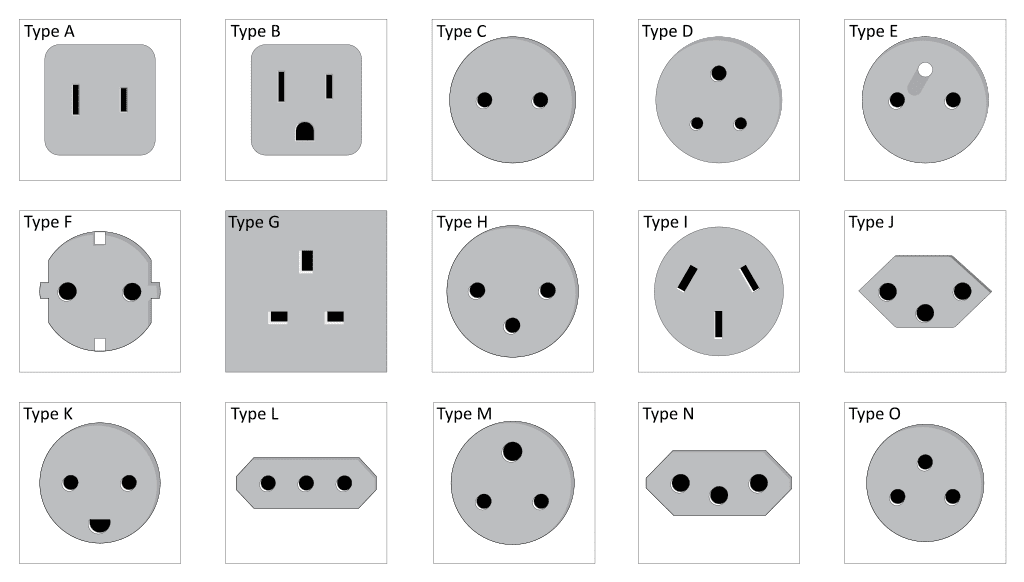
Do I Need a Plug Adapter or Converter? Understanding the Difference
One of the most common questions travelers have is whether they need a plug adapter or a power converter. The answer depends on the type of device you plan to bring and the destination’s voltage.
Pro Tip: If you’re unsure whether your device is dual-voltage, look for the input voltage range printed on the charger or device. Always travel with a plug adapter, even if you don’t need a converter!
Plug adapters: These are small devices that allow you to plug your electronic device into an outlet that has a different plug type. Adapters do not convert voltage; they simply change the plug shape to match the outlet. If your device is dual-voltage, an adapter is all you’ll need.
Power converters: These are necessary when your device’s voltage doesn’t match the country’s power supply. For example, if your device runs on 110-120V (common in the U.S.) and the country you’re visiting uses 220-240V, you’ll need a converter to prevent damaging your electronics.
Dual-voltage devices: Many modern electronics, like laptops, smartphones, and cameras, are dual-voltage, meaning they can handle both 110-120V and 220-240V. Check the label on your device or charger, which will often say “Input: 100-240V,” meaning you won’t need a converter, just an adapter.
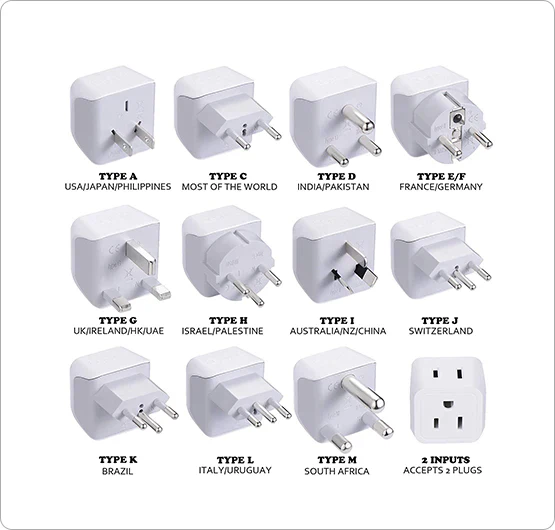
How to Choose the Right Adapter for Your Destination
Choosing the correct plug adapter is essential for staying connected during your travels. Each destination uses a specific plug type, and some countries even use multiple plug types depending on the region. Here’s a guide to help you figure out which adapter you’ll need:
Pro Tip: Invest in a universal adapter. These multi-use adapters can be adjusted to fit different plug types, making them ideal for multi-destination trips.
Europe: Most European countries use Type C plugs, which have two round pins. However, the UK and Ireland use Type G, which has three rectangular pins.
North America: The U.S., Canada, and Mexico use Type A and Type B plugs. Type A has two flat pins, while Type B includes a grounding pin.
Asia: Plug types vary widely across Asia. For example, Japan uses Type A, while China and most of Southeast Asia use Type C or Type G.
Australia and New Zealand: Both countries use Type I, which has two flat angled pins and a grounding pin.
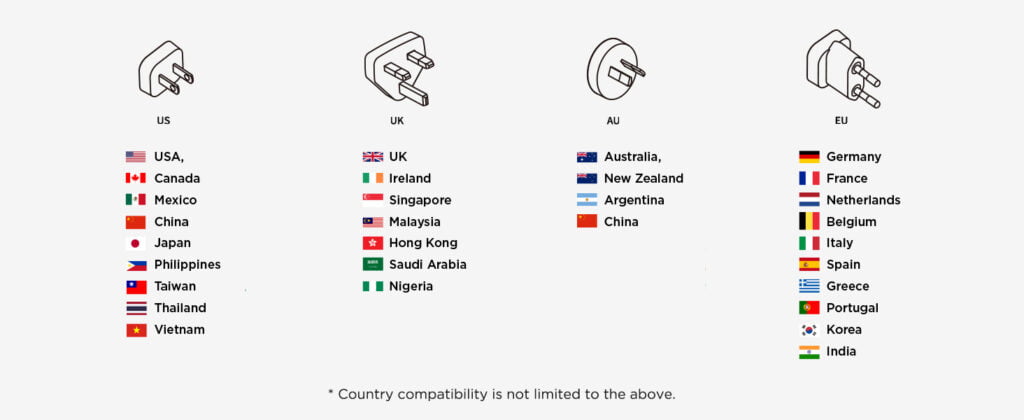
Voltage and Frequency: How to Ensure Your Devices Are Compatible
Voltage and frequency vary from country to country, and using a device with the wrong voltage can damage it. Voltage refers to the electrical potential difference, while frequency is the number of cycles per second (measured in Hertz, Hz).
Pro Tip: For high-powered devices like hair dryers or straighteners, use a voltage converter, or buy a travel-specific version compatible with global voltage standards.
Voltage: Countries like the U.S. and Japan use 110-120V, while most of Europe, Asia, and Africa use 220-240V. If your device is not dual-voltage, plugging it into the wrong voltage outlet can fry your electronics.
Frequency: Most countries use either 50Hz or 60Hz. While the frequency difference is less likely to damage your devices, it can cause malfunctions in certain appliances, such as clocks or electric motors.
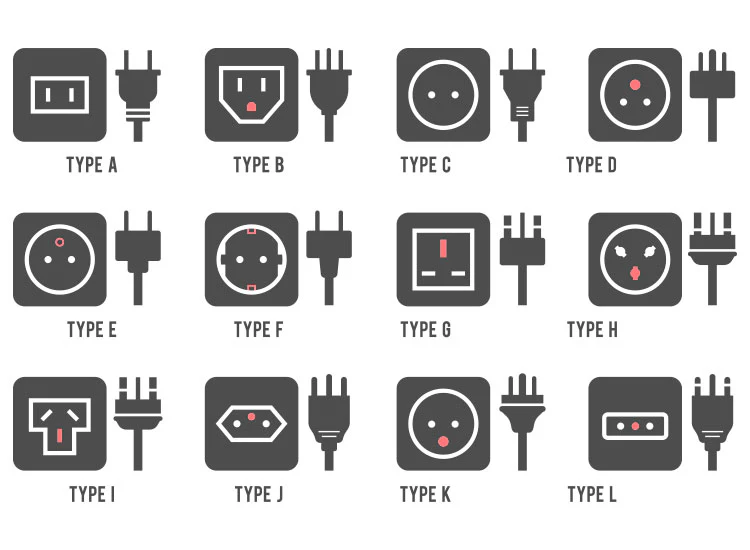
How to Keep Your Devices Safe While Charging Abroad
Using the right plug and adapter is crucial, but keeping your devices safe while charging abroad is equally important. Here’s how to protect your electronics from power surges and other electrical issues:
Pro Tip: Look for adapters with built-in surge protection to save space and protect your devices simultaneously.
Use a surge protector: Power surges can occur unexpectedly, especially in countries with unstable electrical grids. Travel-size surge protectors can prevent damage to your devices.
Avoid overloading outlets: It can be tempting to plug multiple devices into a single adapter, but overloading outlets can lead to overheating and damage to your electronics.
Check the outlet before use: Inspect the outlet for any visible damage or burns before plugging in your device. Using damaged outlets can result in electrical shorts or fires.
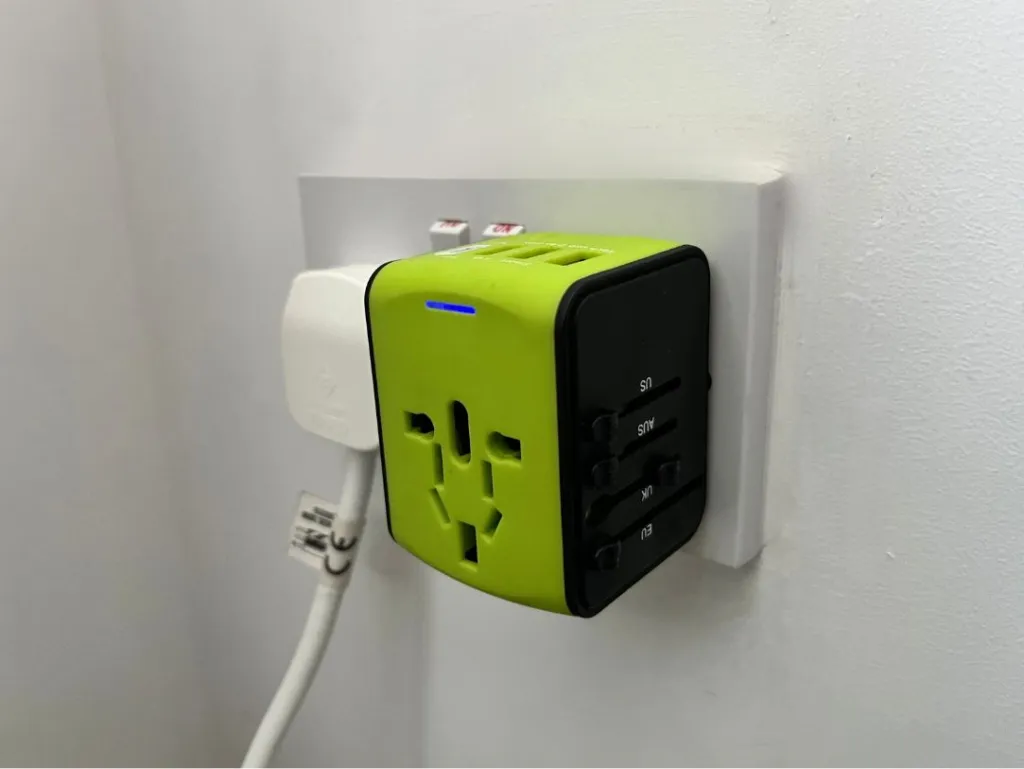
Essential Packing Tips for Adapters and Converters
When traveling, it’s easy to forget essential items like adapters and converters. Here are some packing tips to ensure you’re prepared:
Pro Tip: Consider packing your adapters and chargers in a dedicated travel pouch to keep them organized and easily accessible.
Pack a universal adapter: If you’re traveling to multiple countries, a universal adapter will save you the hassle of carrying multiple plugs.
Label your adapters: Label your adapters with the destination country or plug type. This will help you quickly identify which one to use upon arrival.
Bring a backup: Always bring a spare adapter in case you lose or damage one during your travels.

Top Travel Destinations and Their Plug Types
Here’s a quick guide to the plug types used in some of the world’s most popular travel destinations:
Brazil: Type N/C (127/220V, 60Hz)
United States: Type A/B (120V, 60Hz)
United Kingdom: Type G (230V, 50Hz)
Australia: Type I (230V, 50Hz)
France: Type C (230V, 50Hz)
Japan: Type A (100V, 50/60Hz)
China: Type I/C (220V, 50Hz)
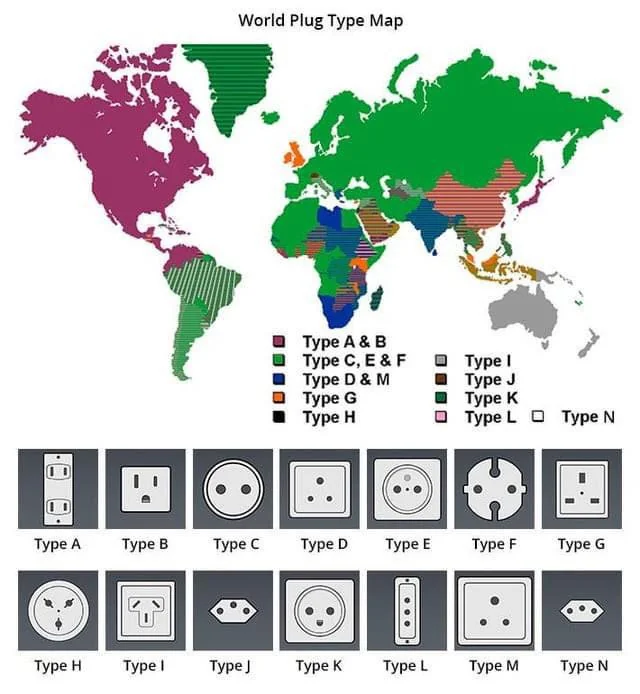
Conclusion: Stay Connected and Powered Up Wherever You Travel
Preparing for your next trip includes more than just packing clothes and booking flights—you also need to ensure your electronic devices will work at your destination. By understanding the plug types and voltage requirements for each country, you’ll avoid unnecessary headaches and ensure your gadgets stay charged throughout your journey. Invest in a good plug adapter or converter, double-check your devices’ voltage, and consider adding surge protection for peace of mind.
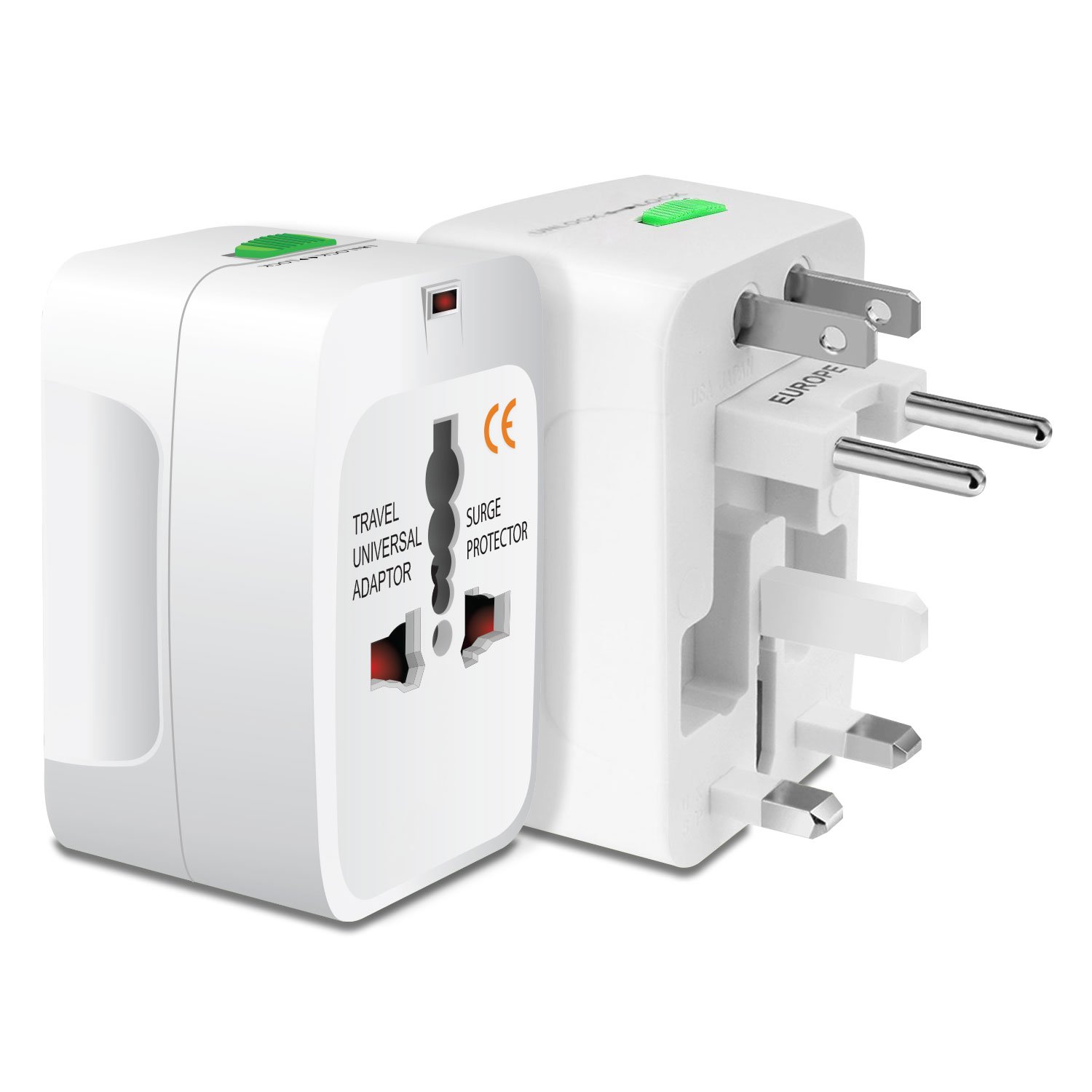
With these tips in mind, you’ll be ready to stay powered up, connected,

You may also be interested in
One Week in Patagonia Unmissable Adventures in Argentina and Chile
If you’re seeking adventure in some of the most stunning…
Exploring the Amalfi Coast 7 Unmissable Activities for a Dream Italian Getaway
The Amalfi Coast, nestled in Italy’s Campania region, is a…
One Week in Thailand Unmissable Experiences from Bangkok to the Islands
Thailand is a land of contrasts, where vibrant cities, ancient…
Hotels in Seoul: Popularity
| Hotel | Stars | Discount | Price before and discount | Select dates |
|---|---|---|---|---|
| Lotte Hotel Seoul | ★★★★★ | -14% | 342 293 | View hotel |
| Tmark Grand Hotel Myeongdong | ★★★★ | - | - | View hotel |
| Pacific Hotel | ★★★★ | - | - | View hotel |
| Solaria Nishitetsu Hotel Seoul Myeongdong | ★★★ | - | - | View hotel |
| Hotel Skypark Central Myeongdong | ★★★★ | - | - | View hotel |
| Nine Tree Premier Hotel Myeongdong 2 | ★★★★ | - | - | View hotel |
| LOTTE City Hotel Myeongdong | ★★★★ | - | - | View hotel |
| Crown Park Hotel Seoul | ★★★ | - | - | View hotel |
| Sotetsu Hotels The Splaisir Seoul Dongdaemun | ★★★★ | - | - | View hotel |
| Ibis Ambassador Myeongdong | ★★★ | - | - | View hotel |



